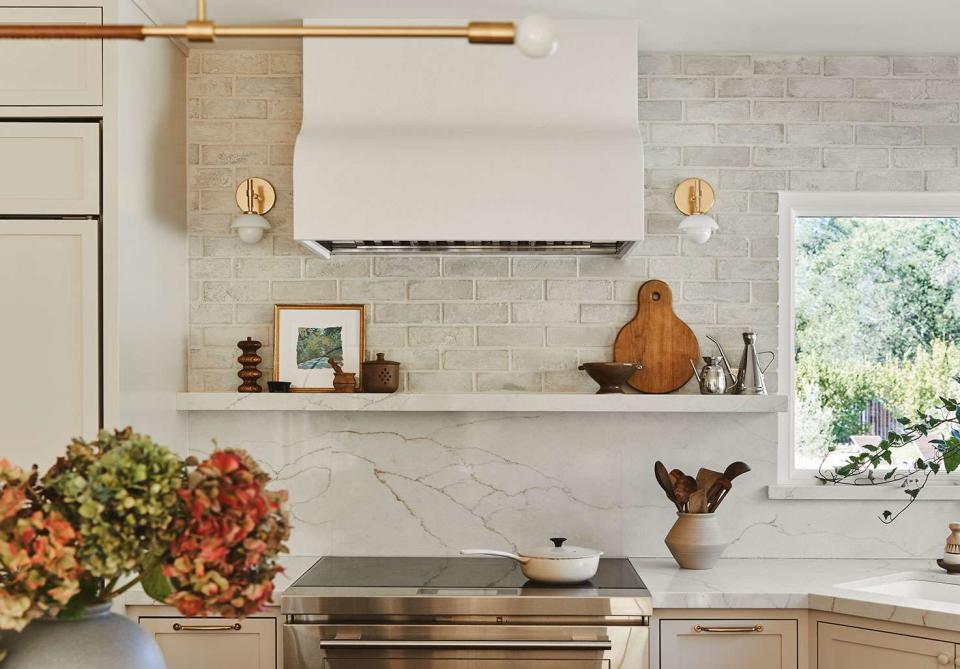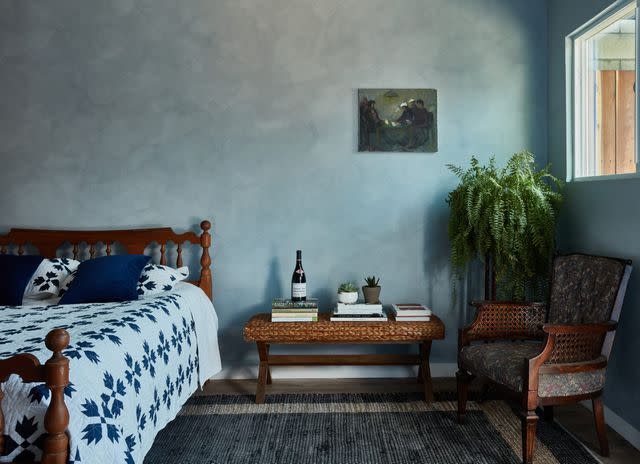Rediscover Limewash Paint, the Old-World Finish That's Trending Again
Learn how to channel the dreamy, romantic homes of Italy using this painting technique.

Sara Ligorria-Tramp; Design: Julie Rose for Velinda Hellen Design
Limewash paint has been around for centuries and yet it remains an often reached-for staple in modern homes today. This method of painting instantly infuses a sense of lived-in, romantic character while simultaneously brightening and softening surfaces with its pale tones. Along with making a marked—and very satisfying—before and after difference, it’s easy to use limewash paint since it’s applied the same way as traditional paint. To help you determine whether limewash is the right finish for you, we’re covering all your FAQs with expert insight.
Meet Our Expert
Larry A. Kuhn, owner of Five Star Painting of Plain City, a Neighborly brand
Jamie Davis, co-founder and owner of Portola Paints
Helene van Os, brand manager for paint brand Pure and Original
Related: Limewashed Brick Can Give Your Home a Lived-In Look—Here's How to Use the Technique
What Is Limewash Paint?
Made famous via Italy's romantic frescos, limewash paint is traditionally made from crushed limestone that's been heated and mixed with water to form a paste. Today, a variety of brands create limewash paint that you can apply yourself to either an interior or exterior wall.
The idea is to make it look like the wall or brick was painted many years ago and has naturally faded via sun and weather, says painting pro Larry A. Kuhn, owner of Five Star Painting of Plain City. Limewash paint has a chalky, almost suede-like look, and the slight contrast in shade adds the depth you would get from a textured wall while still being physically flat.
More and more homeowners are choosing limewash paint for their spaces because of its ability to instantly create texture and add depth to walls. While it looks especially beautiful on brick, it can even transform the most flat and boring drywall.
"The natural, brush-applied limewash dries to create a weathered patina with subtle movement and natural color variation that softens and streaks with age," says Jamie Davis, co-founder and owner of Portola Paints. "In light colors, the effect is generally pretty subtle, while in darker shades the movement and variation in color are more obvious."
Related: 5 Interior Paint Techniques That Will Be Everywhere in 2024, According to Designers
Is Limewash Environmentally Friendly?
Limewash is considered an environmentally friendly option since it's made with natural materials and is usually free of the volatile organic compounds (VOCs) found in traditional paints. The primary ingredient is limestone, which has been crushed, burned, and mixed with water to create a paint-like substance, then mixed with water.
That said, every brand has its own approach to creating limewash paint, so if an eco-friendly product is important to you, then read up on the product ingredients and the brand's sourcing practices.

Where to Use Limewash Paint in Your Home
Limewash paint is quite versatile. You can use it on both interior and exterior masonry, including on drywall applications like plaster, brick, cement, and stucco. That said, Davis recommends not using it on wood or metal surfaces.
And though limewash is bacteria- and mold-resistant, thanks to the high pH level of the lime, Helene van Os, brand manager for Pure and Original, says, "If you're going to use limewash paint in a humid or high-trafficked area, make sure you protect it with a sealer, as lime is porous and more vulnerable to dirt and water." In addition to protecting against dirt and water, she says adding a sealer makes limewashed walls easier to clean.
As for aesthetics, even though limewash paint has an inherent old-world vibe that creates a soft and lived-in look, it still works in a modern setting. "Limewash paint goes with so many styles—it's all about how you mix it in with other materials that are used in the room," says van Os.
Davis adds that achieving modernity with limewash all comes down to color. "The nature of the limewash causes colors to lighten up when applied, so achieving very dark or bright colors can be a challenge," he says. Luckily, many brands now offer a much wider range of colors—both custom and stock—than has traditionally been produced for limewash.
Related: 10 Types of Trim That Will Instantly Elevate Your Home

Tips for Applying Limewash Paint
Limewash paint is fairly easy to use, and is applied similarly to traditional paint. Still, there are a few tricks of the trade. While van Os notes that the application of limewash requires a bit more elbow grease than regular paint, she says that once you know the dos and don'ts the technique is very easy to adopt.
Use a primer: "Since the paint is mineral, you will, in most cases, need a coat of special primer for proper adherence," says van Os.
Apply with a stain brush or block: You can't apply limewash paint with a roller or spray. Instead, both van Os and Davis recommend using a four to six-inch block or stain brush to define the perfect texture.
Consider coverage: Limewash has a more translucent finish, so the underlying surface may affect the final color. Keep this in mind when planning the number of coats needed for full coverage.
Keep a wet edge: Keep a wet edge while working to avoid "lap" lines, and remember to cut in as you go. Misting as you work will help with this. "Standard-sized walls and rooms are pretty easy," Davis says. "The process gets a bit trickier if you are working in a room with coved ceilings or stair walls."
Give it plenty of time to dry: Limewash typically dries through a process referred to as carbonation, which can take several days to fully complete. Avoid touching or disturbing the painted surface until it's completely dry.
Related: What to Consider Before Painting Brick—and How to Do It Right
Read the original article on Martha Stewart.

